Themed collection Molecular metal-containing soft materials

Molecular metal-containing soft materials
Welcome to this themed issue of Dalton Transactions entitled “Molecular metal-containing soft materials”.

Dalton Trans., 2018,47, 14123-14124
https://doi.org/10.1039/C8DT90168F
Molecular rectifiers based on five-coordinate iron(III)-containing surfactants
The state-of-the-art of metallorganic-based molecular rectification is reviewed with an emphasis on asymmetric five-coordinate FeIII-containing surfactants in electrode|LB film|electrode assemblies.
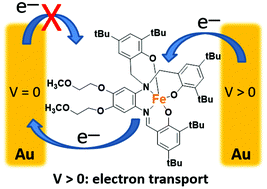
Dalton Trans., 2018,47, 14153-14168
https://doi.org/10.1039/C8DT02891E
Gold nanocatalysts supported on carbon for electrocatalytic oxidation of organic molecules including guanines in DNA
Recent accomplishments in the syntheses of Au nanoparticles and nanocluster supported on carbon materials and applications to electroxidation are reviewed.
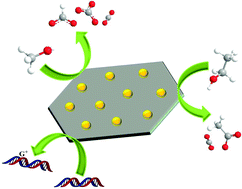
Dalton Trans., 2018,47, 14139-14152
https://doi.org/10.1039/C8DT01966E
Metal bis(acetylide) complex molecular wires: concepts and design strategies
This Perspective highlights relationships between chemical features of metal bis(acetylide) complexes and their electrical response in a molecular junction.
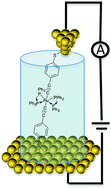
Dalton Trans., 2018,47, 14125-14138
https://doi.org/10.1039/C8DT02103A
Multiheme proteins: effect of heme–heme interactions
This Frontier illustrates a brief personal account on the effect of heme–heme interactions in dihemes which thereby discloses some of the evolutionary design principles involved in multiheme proteins for their diverse structures and functions.
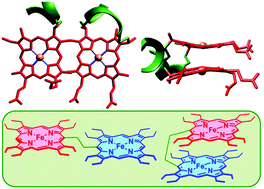
Dalton Trans., 2018,47, 14388-14401
https://doi.org/10.1039/C8DT00518D
Solid-state sensors based on Eu3+-containing supramolecular polymers with luminescence colour switching capability
A europium-based metallosupramolecular polymer is reported that exhibits changes of the luminescence colour in response to different types of analytes.

Dalton Trans., 2018,47, 14184-14188
https://doi.org/10.1039/C8DT01580E
Fabrication of zinc-dicarboxylate- and zinc-pyrazolate-carboxylate-framework thin films through vapour–solid deposition
Fabrication of 3-dimensional MOF thin films has been investigated through the conversion of ZnO thin film via a pure vapour–solid deposition reaction at ambient pressure.

Dalton Trans., 2018,47, 14179-14183
https://doi.org/10.1039/C8DT00352A
Double layer zinc–UDP coordination polymers: structure and properties
Double layer Zn–UDP coordination polymers with potentially open sites can be used for heterogeneous fluorescent sensors of amino acids.
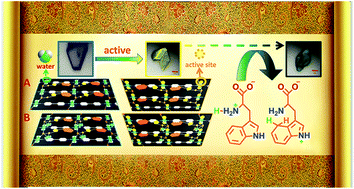
Dalton Trans., 2018,47, 14174-14178
https://doi.org/10.1039/C8DT01537F
Optical readout of controlled monomer–dimer self-assembly
Diazepinoporphyrazines as optical signaling agents.

Dalton Trans., 2018,47, 14169-14173
https://doi.org/10.1039/C8DT00384J
Solvent-free thiophene-based electrolytes: synthesis of new liquid-crystalline ionic conductors for batteries: part I
We report the synthesis of new liquid crystalline thiophene esters, ThBz1 and ThBz2, for use in lithium-ion batteries as new, safe, solvent-free ionic conductors.

Dalton Trans., 2018,47, 15714-15724
https://doi.org/10.1039/C8DT02968G
Observation of current rectification by the new bimetallic iron(III) hydrophobe [FeIII2(LN4O6)] on Au|LB-molecule|Au devices
A new bimetallic iron hydrophobe, [FeIII2(LN4O6)] (1) forms well-defined films used for current–voltage measurements and shows unquestionable molecular rectification.
![Graphical abstract: Observation of current rectification by the new bimetallic iron(iii) hydrophobe [FeIII2(LN4O6)] on Au|LB-molecule|Au devices](/en/Image/Get?imageInfo.ImageType=GA&imageInfo.ImageIdentifier.ManuscriptID=C8DT03158D&imageInfo.ImageIdentifier.Year=2018)
Dalton Trans., 2018,47, 14352-14361
https://doi.org/10.1039/C8DT03158D
Luminescent liquid crystalline hybrid materials by embedding octahedral molybdenum cluster anions with soft organic shells derived from tribenzo[18]crown-6
Crown ethers and their derivatives are versatile building blocks for the design of supramolecular materials.
![Graphical abstract: Luminescent liquid crystalline hybrid materials by embedding octahedral molybdenum cluster anions with soft organic shells derived from tribenzo[18]crown-6](/en/Image/Get?imageInfo.ImageType=GA&imageInfo.ImageIdentifier.ManuscriptID=C8DT03254H&imageInfo.ImageIdentifier.Year=2018)
Dalton Trans., 2018,47, 14340-14351
https://doi.org/10.1039/C8DT03254H
A new series of Cd(II) metal–organic architectures driven by soft ether-bridged tricarboxylate spacers: synthesis, structural and topological versatility, and photocatalytic properties
Two multifunctional, ether-bridged tricarboxylic acids were used as unexplored and highly versatile building blocks for the hydrothermal generation of eight new cadmium(II) metal–organic architectures.
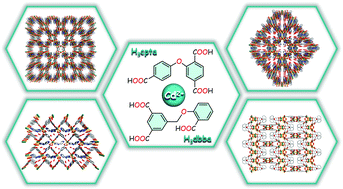
Dalton Trans., 2018,47, 14327-14339
https://doi.org/10.1039/C8DT02467G
Structural evolution in metallomicroemulsions – the effect of increasing alcohol hydrophobicity
Small-angle neutron scattering and contrast variation has been employed to quantify how a series of alcohols with increasing hydrophobicity exert different abilities to structure a model toluene based metallomicroemulsion – a microemulsion system stabilised with a metallosurfactant.
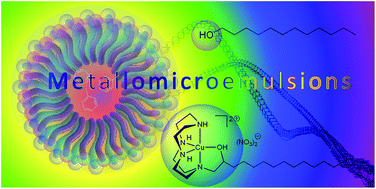
Dalton Trans., 2018,47, 14211-14217
https://doi.org/10.1039/C8DT02031K
Lanthanide extraction selectivity of a tripodal carbamoylmethylphosphine oxide ligand system
Lanthanide extraction selectivity is attained by variation of the ligand structure and extraction conditions for a series of CMPO-based ligands.
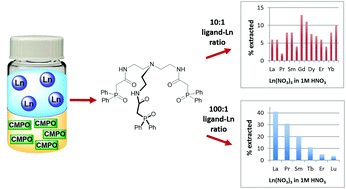
Dalton Trans., 2018,47, 14318-14326
https://doi.org/10.1039/C8DT02239A
Stereocontrolled self-assembly and photochromic transformation of lanthanide supramolecular helicates
Stereocontrolled self-assembly of a dinuclear triple-stranded europium helicate (Eu2L3) based on DTE-functionalized ligands has been achieved via the chiral-induction strategy.

Dalton Trans., 2018,47, 14204-14210
https://doi.org/10.1039/C8DT01808A
Metallosomes for biomedical applications by mixing molybdenum carbonyl metallosurfactants and phospholipids
New photo-CORM metallosomes with low cell toxicity were prepared from organometallic metallosurfactants and phospholipids.

Dalton Trans., 2018,47, 14293-14303
https://doi.org/10.1039/C8DT01584H
Diruthenium(II)-capped oligothienylethynyl bridged highly soluble organometallic wires exhibiting long-range electronic coupling
Highly soluble diruthenium(II) organometallic molecular wires with thienylethynyl π-conjugated bridges have been synthesized by varying the chain length to access long-range electronic communication.

Dalton Trans., 2018,47, 14304-14317
https://doi.org/10.1039/C8DT01818A
Self-assembly of porphyrin hexamers via bidentate metal–ligand coordination
UV/vis, NMR and SANS (right) demonstrate self-assembly of Zn porphyrin hexamers (green) with bidentate DABCO (orange) into cylindrical rods (left).

Dalton Trans., 2018,47, 14277-14287
https://doi.org/10.1039/C8DT01572D
Ferroelectric and luminescence properties of zinc(II) and platinum(II) soft complexes
Zinc(II) and platinum(II) complexes [M(X-4-C18-salmmen)] (M = Zn (1) and Pt (2), X = R, S (optical isomer) and rac (racemate), salmmen = N,N′-monomethylenebis-salicylideneimine) were synthesized and investigated.
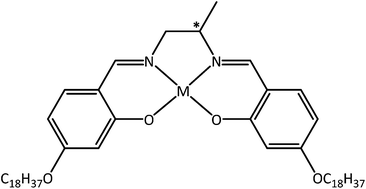
Dalton Trans., 2018,47, 14288-14292
https://doi.org/10.1039/C8DT01100A
Hydrogen-bonded metallo-supramolecular polymers based on ruthenium or iron complexes for the selective extraction of single-walled carbon nanotubes
Selective extraction of semiconducting SWNT via entangled surface modification by H-bonded metallo-supramolecular polymer was achieved.
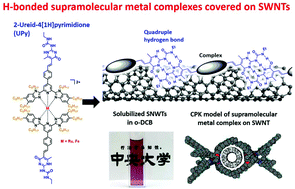
Dalton Trans., 2018,47, 14195-14203
https://doi.org/10.1039/C8DT01573B
Exploring the cellular uptake and localisation of phosphorescent rhenium fac-tricarbonyl metallosurfactants as a function of lipophilicity
The cellular distribution of amphiphilic rhenium(I) complexes is tuned by the nature of the axial donor.
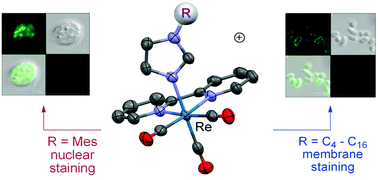
Dalton Trans., 2018,47, 14241-14253
https://doi.org/10.1039/C8DT00669E
Luminescent copper(I) complexes with bisphosphane and halogen-substituted 2,2′-bipyridine ligands
Light-emitting electrochemical cells with Cu(I) emitters with halo-substituted 2,2′-bipyridine ligands display orange electroluminescence and short turn-on times.
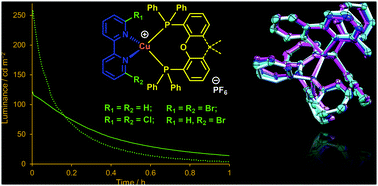
Dalton Trans., 2018,47, 14263-14276
https://doi.org/10.1039/C8DT01338A
Terpyridine-based metallo-organic cages and supramolecular gelation by coordination-driven self-assembly and host–guest interaction
Dimetallo-cages connected with dialkylammonium salts via host–guest interactions resulted in thermodynamic polymer metallo-gels.

Dalton Trans., 2018,47, 14227-14232
https://doi.org/10.1039/C8DT01044G
Photoswitchable transition metal complexes with azobenzene-functionalized imine-based ligands: structural and kinetic analysis
We report on the characterization of two imine type ligands containing photoresponsive azobenzene units as side groups and their transition metal ions complexes.
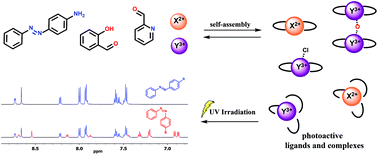
Dalton Trans., 2018,47, 14254-14262
https://doi.org/10.1039/C8DT00590G
Dual emissions and thermochromic luminescences of isomorphic chiral twofold interpenetrated 3-D nets built from I1O2 type hybrid inorganic–organic frameworks of [NH2(CH3)2]3[Pb2X3(BDC)2] (X = Br, I)
Two pairs of isomorphic chiral twofold interpenetrated 3-D nets were built from I1O2 type hybrid inorganic–organic frameworks and show dual emissions and thermochromism.
![Graphical abstract: Dual emissions and thermochromic luminescences of isomorphic chiral twofold interpenetrated 3-D nets built from I1O2 type hybrid inorganic–organic frameworks of [NH2(CH3)2]3[Pb2X3(BDC)2] (X = Br, I)](/en/Image/Get?imageInfo.ImageType=GA&imageInfo.ImageIdentifier.ManuscriptID=C8DT01469H&imageInfo.ImageIdentifier.Year=2018)
Dalton Trans., 2018,47, 14233-14240
https://doi.org/10.1039/C8DT01469H
An in situ spectroelectrochemical study on the orientation changes of an [FeIIILN2O3] metallosurfactant deposited as LB Films on gold electrode surfaces
An iron metallosurfactant in Langmuir–Blodgett films undergoes reduction which is accompanied by pronounced structural rearrangements of the adsorbed molecule.
![Graphical abstract: An in situ spectroelectrochemical study on the orientation changes of an [FeiiiLN2O3] metallosurfactant deposited as LB Films on gold electrode surfaces](/en/Image/Get?imageInfo.ImageType=GA&imageInfo.ImageIdentifier.ManuscriptID=C8DT00333E&imageInfo.ImageIdentifier.Year=2018)
Dalton Trans., 2018,47, 14218-14226
https://doi.org/10.1039/C8DT00333E
Concentration dependent supramolecular interconversions of triptycene-based cubic, prismatic, and tetrahedral structures
New insight into the molecular fission–fusion process is obtained with the characterization of a stable intermediate prismatic cage.
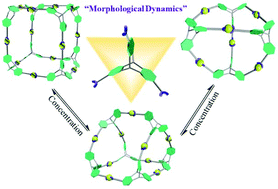
Dalton Trans., 2018,47, 14189-14194
https://doi.org/10.1039/C7DT04571A
Mixed-matrix materials using metal–organic polyhedra with enhanced compatibility for membrane gas separation
The dispersion of metal–organic polyhedra into polymer thin-films exploits the host/guest capabilities of the former and the processability of the latter.

Dalton Trans., 2018,47, 7905-7915
https://doi.org/10.1039/C8DT00082D
Electrostatic self-assembled nanoparticles based on spherical polyelectrolyte brushes for magnetic resonance imaging
Electrostatic self-assemblies based on SPBs and Gd-DTPA-NO-C4 exhibit perfect relaxometric performance.

Dalton Trans., 2018,47, 7663-7668
https://doi.org/10.1039/C8DT01069B
Enhanced singlet oxygen generation of a soft salt through efficient energy transfer between two ionic metal complexes
A novel soft salt based photosensitizer was successfully developed for application in photodynamic therapy of cancer cells for the first time.
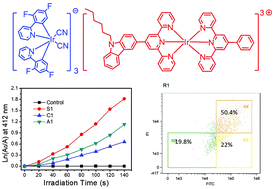
Dalton Trans., 2018,47, 5582-5588
https://doi.org/10.1039/C8DT00720A
About this collection
Welcome to the themed issue on Molecular metal-containing soft materials. This collection is focused on emerging trends related to metallosurfactants, metallomesogens, metallopolymers, metallorganic frameworks, supramolecular, and hierarchical materials that take advantage of the geometric, redox, and magnetic properties of 3d, 4d, 5d transition metals, lanthanides, and main group metals to build up organized and often responsive architectures based on “soft” organic scaffolds.
It is Guest Edited by Claudio Verani (Wayne State University) and Richard Layfield (University of Sussex).